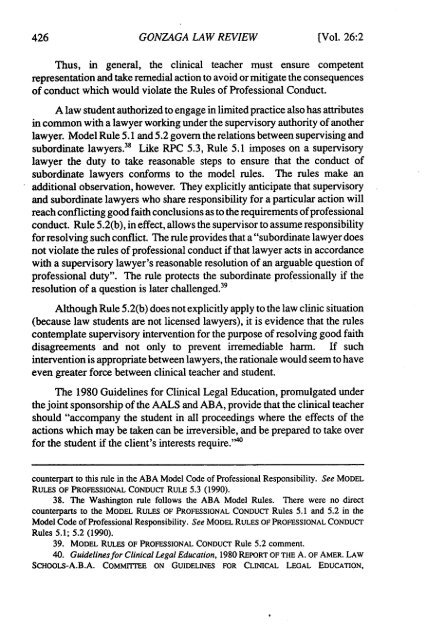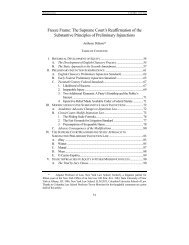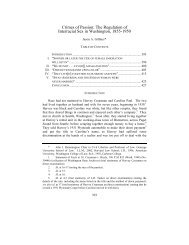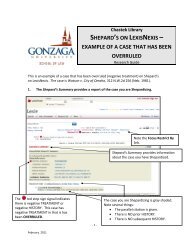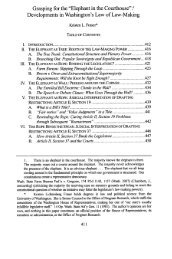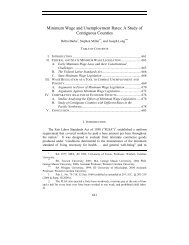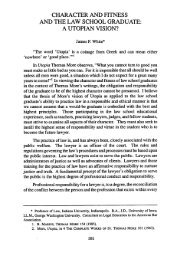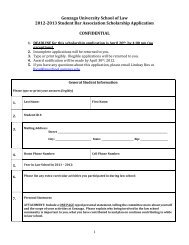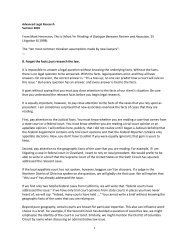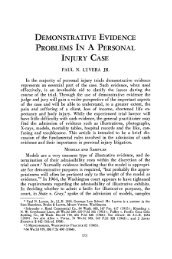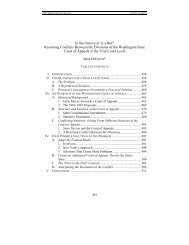professional responsibility, student practice, and the clinical
professional responsibility, student practice, and the clinical
professional responsibility, student practice, and the clinical
Create successful ePaper yourself
Turn your PDF publications into a flip-book with our unique Google optimized e-Paper software.
GONZAGA LAW REVIEW<br />
[Vol. 26:2<br />
Thus, in general, <strong>the</strong> <strong>clinical</strong> teacher must ensure competent<br />
representation <strong>and</strong> take remedial action to avoid or mitigate <strong>the</strong> consequences<br />
of conduct which would violate <strong>the</strong> Rules of Professional Conduct.<br />
A law <strong>student</strong> authorized to engage in limited <strong>practice</strong> also has attributes<br />
in common with a lawyer working under <strong>the</strong> supervisory authority of ano<strong>the</strong>r<br />
lawyer. Model Rule 5.1 <strong>and</strong> 5.2 govern <strong>the</strong> relations between supervising <strong>and</strong><br />
subordinate lawyers. 38 Like RPC 5.3, Rule 5.1 imposes on a supervisory<br />
lawyer <strong>the</strong> duty to take reasonable steps to ensure that <strong>the</strong> conduct of<br />
subordinate lawyers conforms to <strong>the</strong> model rules. The rules make an<br />
additional observation, however. They explicitly anticipate that supervisory<br />
<strong>and</strong> subordinate lawyers who share <strong>responsibility</strong> for a particular action will<br />
reach conflicting good faith conclusions as to <strong>the</strong> requirements of <strong>professional</strong><br />
conduct. Rule 5.2(b), in effect, allows <strong>the</strong> supervisor to assume <strong>responsibility</strong><br />
for resolving such conflict. The rule provides that a "subordinate lawyer does<br />
not violate <strong>the</strong> rules of <strong>professional</strong> conduct if that lawyer acts in accordance<br />
with a supervisory lawyer's reasonable resolution of an arguable question of<br />
<strong>professional</strong> duty". The rule protects <strong>the</strong> subordinate <strong>professional</strong>ly if <strong>the</strong><br />
resolution of a question is later challenged. 39<br />
Although Rule 5.2(b) does not explicitly apply to <strong>the</strong> law clinic situation<br />
(because law <strong>student</strong>s are not licensed lawyers), it is evidence that <strong>the</strong> rules<br />
contemplate supervisory intervention for <strong>the</strong> purpose of resolving good faith<br />
disagreements <strong>and</strong> not only to prevent irremediable harm. If such<br />
intervention is appropriate between lawyers, <strong>the</strong> rationale would seem to have<br />
even greater force between <strong>clinical</strong> teacher <strong>and</strong> <strong>student</strong>.<br />
The 1980 Guidelines for Clinical Legal Education, promulgated under<br />
<strong>the</strong> joint sponsorship of <strong>the</strong> AALS <strong>and</strong> ABA, provide that <strong>the</strong> <strong>clinical</strong> teacher<br />
should "accompany <strong>the</strong> <strong>student</strong> in all proceedings where <strong>the</strong> effects of <strong>the</strong><br />
actions which may be taken can be irreversible, <strong>and</strong> be prepared to take over<br />
for <strong>the</strong> <strong>student</strong> if <strong>the</strong> client's interests require."<br />
counterpart to this rule in <strong>the</strong> ABA Model Code of Professional Responsibility. See MODEL<br />
RULES OF PROFESSIONAL CONDuCT RULE 5.3 (1990).<br />
38. The Washington rule follows <strong>the</strong> ABA Model Rules. There were no direct<br />
counterparts to <strong>the</strong> MODEL RULES OF PROFESSIONAL CONDUCT Rules 5.1 <strong>and</strong> 5.2 in <strong>the</strong><br />
Model Code of Professional Responsibility. See MODEL RULES OF PROFESSIONAL CONDUCT<br />
Rules 5.1; 5.2 (1990).<br />
39. MODEL RULES OF PROFESSIONAL CONDUCT Rule 5.2 comment.<br />
40. Guidelines for Clinical Legal Education, 1980 REPORT OF THE A. OF AMER. LAW<br />
SCHOOLS-A.B.A. COMMITTEE ON GUIDELINES FOR CLINICAL LEGAL EDUCATION,


